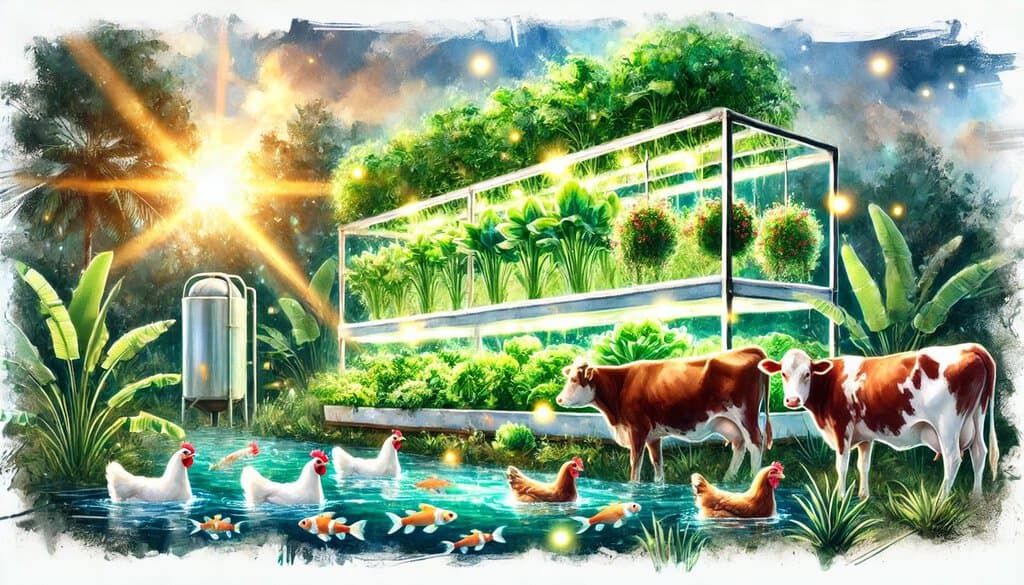Aquaponics can indeed be used for livestock feed production, offering an innovative and sustainable approach to addressing feed challenges in animal husbandry. This method combines aquaculture (fish farming) with hydroponics (soilless plant cultivation) to create a symbiotic system that can produce both fish and plant-based feed for livestock.
Below is a video about one of several hydroponic systems that grow fodder for livestock. I can’t see any reason why you shouldn’t be able to grow fodder using aquaponics. I would say that as long as you have a good enough filter to remove any solids, so you don’t fill the trays with fish poo and other solids, and/or you don’t experience mold problems, you are good to go. Comment below if you have tested a similar system like this with aquaponics!
Aquatic Plants as Livestock Feed
Aquaponics can be used to cultivate various plants that have potential as livestock feed. Some species that have shown promise include:
- Myriophyllum aquaticum
- Limnobium laevigatum
- Lemna minor (duckweed)
- Salvinia molesta
These aquatic plants can fulfill many of the nutritional requirements of productive animal species[1]. Myriophyllum aquaticum and Lemna minor, in particular, stand out as alternative food sources for different animal species, opening up possibilities for aquaponic fodder production[1].
Nutritional Value
Aquatic plants grown in aquaponic systems can offer significant nutritional benefits:
- High protein content
- Essential minerals (calcium, phosphorus)
- Favorable energy content
However, it’s important to note that some species, like Salvinia molesta, may have limited value as fodder due to high lignin concentrations, which could affect digestibility[1].
I want to add that barley sprouts would grow very well in aquaponics, but it requires a lot of area to produce enough fodder for many livestock. As a supplement for dry feed in the winter, I think the cows would come home for that.
Advantages of Aquaponic Feed Production
- Sustainability: Aquaponics can help control waste accumulation from fish farming while producing valuable plant-based feed[1].
- Water efficiency: The system uses significantly less water compared to traditional agriculture[7].
- Continuous production: Aquaponics can provide a year-round supply of green forage for livestock feeding[4].
- Waste reduction: The system can transform low-value organic wastes into high-quality feed, promoting a circular economy approach[3].
- Space efficiency: Aquaponic systems can be implemented in urban areas or regions with limited agricultural land[4].
Challenges and Considerations
While aquaponics offers numerous benefits for livestock feed production, there are some challenges to consider:
- pH balance: The optimal pH for fish tends to be above 7.0, while most crop plants prefer a pH around 6.0[7]. Most fish can thrive in pH below 7, see our list of best fish for aquaponics.
- Expertise required: Managing both fish and plant production effectively requires specialized skills[7].
- Initial setup time: It takes time for an aquaponic system to become fully operational and productive[7].
- Feed quality: The nutritional content of aquaponic-grown feed may vary, and supplementation might be necessary to meet all livestock nutritional requirements.
Conclusion
Aquaponics presents a promising avenue for livestock feed production, offering a sustainable and efficient method to address feed challenges. By integrating fish farming with plant cultivation, this system can produce valuable feed resources while minimizing environmental impact. However, successful implementation requires careful consideration of the system’s complexities and the specific nutritional needs of the target livestock. As research in this field continues to evolve, aquaponics may play an increasingly important role in sustainable livestock feed production strategies.
External sources:
[1] https://www.semanticscholar.org/paper/a8a25ed196af01f1d3f6f2925072b037186f9aee
[2] https://www.semanticscholar.org/paper/9752969387ff6e137bdb7ea5d45783ab356edc04
[3] https://pubmed.ncbi.nlm.nih.gov/36634163/
[4] https://www.semanticscholar.org/paper/c4628f84d4f78c0bb4b9ba5d444c33a459505edb
[5] https://www.semanticscholar.org/paper/b4f73097d2ce5e697178ca2207c596aa9e213726
[6] https://www.semanticscholar.org/paper/5c4fd5fc37506d6f5b464fe958209f36d5c17ced
[7] https://www.semanticscholar.org/paper/7911922e19adf73abdc073e9efeff7130acd7fbd


Great site I love the way it’s heading, can’t wait until you have some more edible plants like leafy greens and herbs, I have lots of fish, I have been an aquarium guy for 20 years. I would really like to see how to grow some healthy foods using aquaponics,
Thanks Brian for your kind words. I’m currently working on a large plant database that I hope to publish within the year. I’m an aquarium guy myself and the thought of growing my own vegs combined with my fish hobby seems almost too good to be true, but the plants in my tanks looks awesome, so why not grow something at the top too right? Hope to see you back here soon!